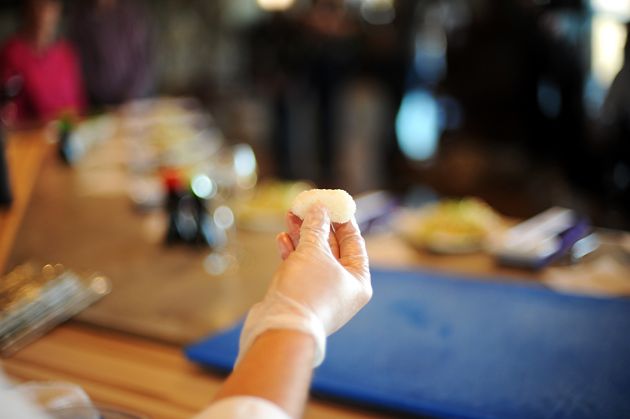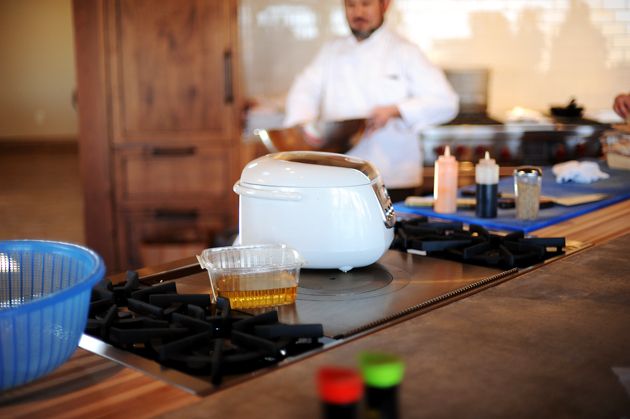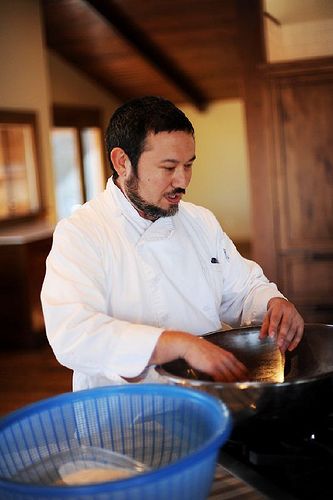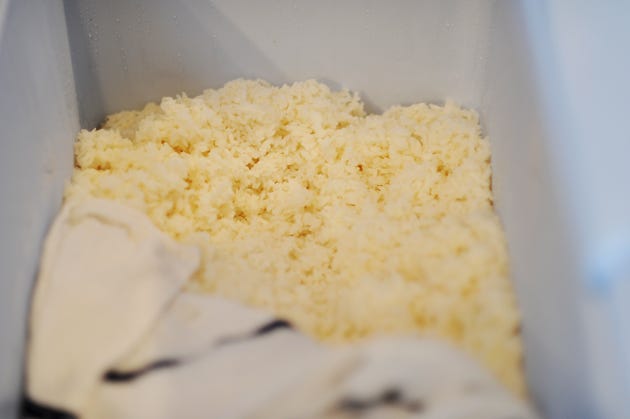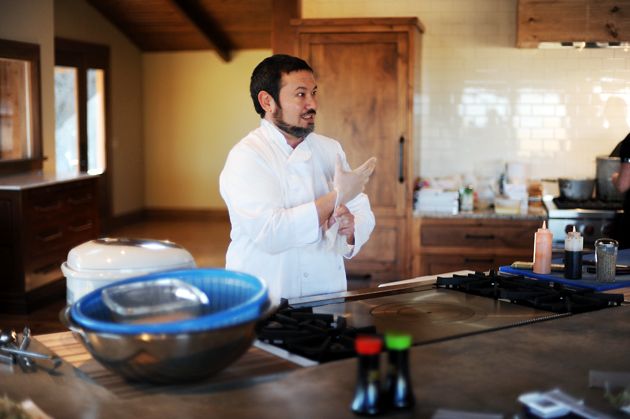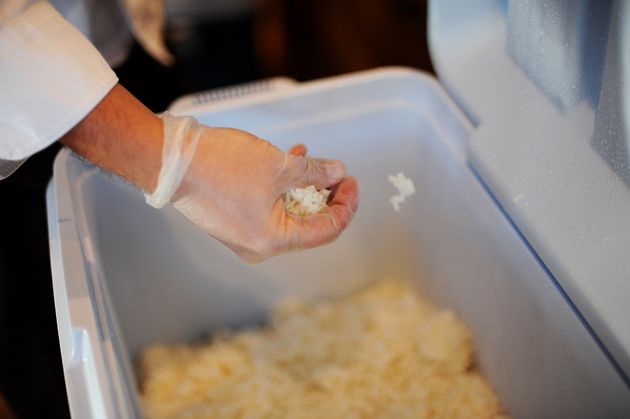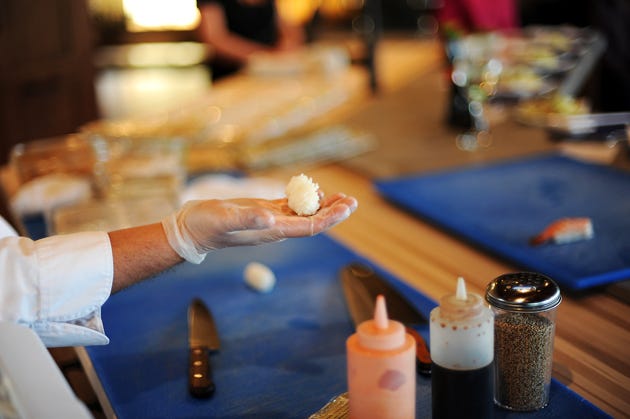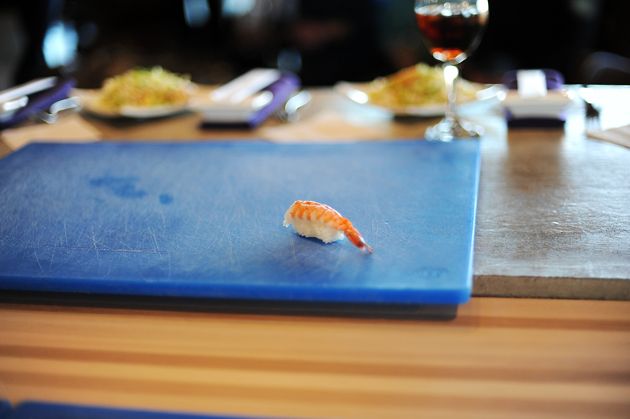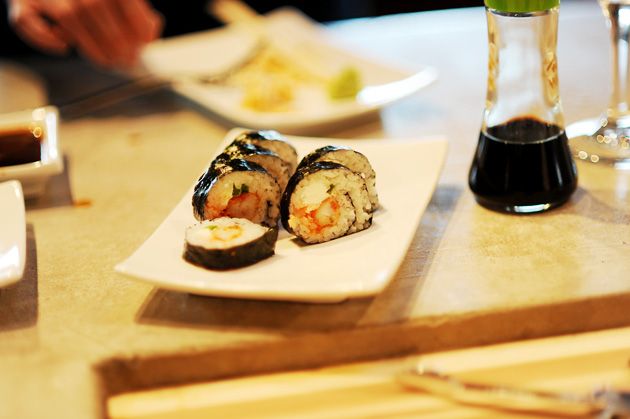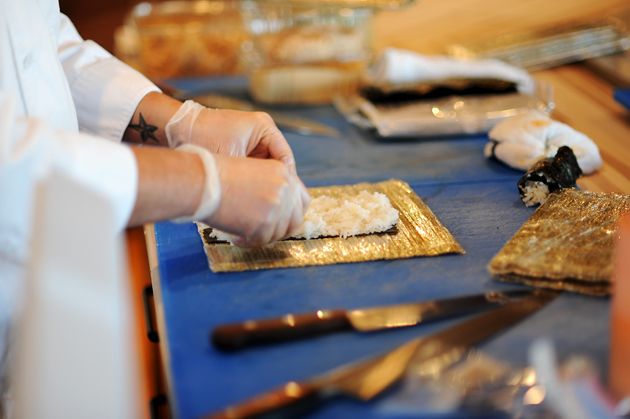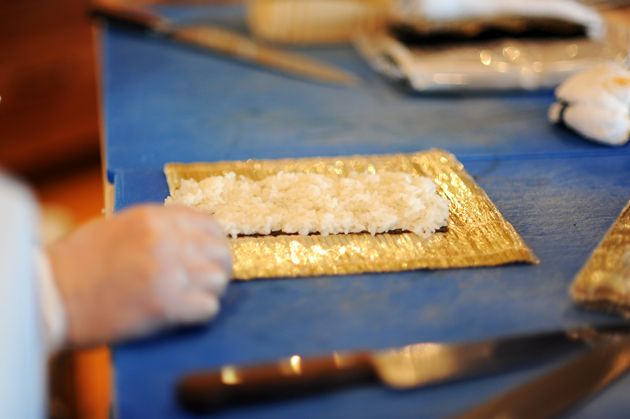This is the first of several sushi lessons brought to you by me, displaced sushi lover, and Cody, a half-Japanese sushi chef from the big city. Cody visited the ranch last week (a birthday present from Marlboro Man, who figured it was the only thing on earth besides a pug that I would possibly want) and spent a few hours deconstructing the basics of sushi so that sad souls like me would have the skills to prepare it from time to time. Or every day.
I love sushi so much.
Today, we’re going to start with the basic building block of sushi: rice. Rice is the basis of sushi. I repeat: Rice is the basis of sushi. According to sushi chef Cody, you could slap a little slice of Spam on a small pillow of rice and it would technically qualify as sushi.
Spam Sushi? Gross me out the door. Though I’ll bet my dad would love it. He learned to love Spam in Vietnam.
Sushi has an interesting beginning: people in China (funny, since sushi is a Japanese dish) used to cure large pieces of fish in between two flat layers of vinegar-soaked rice. They’d create a flat layer of rice, pour a vinegar solution over it, then lay a single layer of fish all over the rice. Then they’d top it with another vinegar-soaked layer of rice and let it cure for a length of time as a means of preserving it. When the fish was ready, they’d discard the rice and keep the fish. I guess somewhere along the way, someone got the munchies early, grabbed a big mouthful of the fish and rice, and decided it was a treat in itself.
I would have been that person.
According to Cody the Sushi Chef, the first step toward making perfect sushi rice is to cook the rice properly.
1. Use short or medium-grain rice. It’s more starchy and round than the long-grain variety, which just won’t hold together well enough to support ingredients in sushi. Many stores now sell specifically-labeled “sushi rice”.
2. Before you cook it, wash/rinse the rice until the water runs totally clear—about five or six times. If you don’t thoroughly rinse the rice, it’ll end up in a big, sticky ball. There’s enough internal starch in the rice for it to sufficiently hold together for sushi, so get all the stuff on the outside OFF by rinsing well.
3. Use a rice cooker/steamer. Rice made on the stovetop will not work for sushi; it won’t be the right consistency. Rice cookers are widely available for as low as $12.
4. Add the rinsed rice to the rice cooker with equal parts water, and follow the directions for the rice cooker.
After it’s done, transfer the cooked rice to a large mixing bowl.
The second step for making perfect sushi rice is to add a vinegar solution called the “su“.
Sushi Su
4 parts rice wine vinegar
2 parts sugar
1 part sake or mirin wine
You’ll need 1 part sushi su for every 4 parts rice.
So using the above proportions, here’s a sample recipe for sushi rice:
4 cups short grain/sushi rice
1 cup rice wine vinegar
1/2 cup sugar
1/4 cup sake or mirin (a Japanese rice wine)
1. Heat vinegar, sugar, and sake or mirin in a saucepan just to dissolve and combine. Allow to cool to room temperature.
2. Cook rice according to rice cooker directions. Transfer to large mixing bowl.
3. Pour su (vinegar mixture) over the rice, gently folding to incorporate.
4. Let rice stand for 10 minutes, then fold again.
Rice should be shiny, not mushy and have a slightly tart/sweet taste. Cover with a warm, wet towel and keep warm.
Cody brought a whole cooler full of sushi rice, the showoff. Sushi rice should be slightly warm when it’s time to make the Nigiri or Sushi Rolls.
We’ll get into this much more on another day, but just to give you a little primer: Nigiri is the classic piece-of-fish-on-top-of-a-pillow-of-rice style of sushi that everyone recognizes.
No. Cody the Sushi Chef is not a medical technician. He’s simply putting on a pair of food-grade plastic gloves to make handling the sushi easier.
(But doesn’t he look like he’s about to perform…an exam?)
(Sorry, Cody.)
To form the rice for nigiri sushi, Cody grabs a heaping tablespoon of the sushi rice…
Then he works it around in his hand…
Forming it…
Until it’s the shape of a small “pillow.” Then he places a piece of fish (shrimp, yellowfin tuna, yellowtail, salmon) on top of the pillow of rice.
Mmmmm…hello, lover. I want to dip you in wasabi-clouded soy sauce and pet you and dress you up and play with you and call you George. And then I want to eat you.
*I’ll be showing you how to prepare the shrimp necessary for this delicious nigiri sushi in the coming days; it’s a piece of cake. But today? It’s about the rice, baby.
The most common form of sushi these days, accounting for almost 90% of sushi sold in Cody’s restaurant, is the Sushi Roll. I’m obsessed with sushi rolls, and you wouldn’t believe the variety Cody makes.
We’ll be covering all the details regarding the seaweed and other ingredients for different sushi rolls during the course of our sushi journey together…but here, I wanted to show you what the layer of sushi rice looks like on the sheet of dried seaweed. Do you see how the rice is spread into a sheet, but has still maintained it’s light, non-mushy quality?
It’s all about the rice, baby. It’s all about the rice.
Here’s a little supporting video footage of Cody the Sushi Chef discussing sushi rice. We didn’t have our good mic or lighting in place yet, but it’ll at least allow you to be there with us and listen to Cody. He was the nicest sushi chef I’ve ever met.
He’s also the only sushi chef I’ve ever met.
But I’d venture a guess he’s one of the nicer ones.
Enjoy the video! Some of the information is a little redundant, but he does throw in a couple of helpful nuggets along the way. (And excuse the pesky clicking of my still camera. I couldn’t get enough.)
Sushi Rice, by Cody the Sushi Chef from Pioneer Woman on Vimeo.
(And here’s the HD version, since I secretly want to be a nerd):
Untitled from Pioneer Woman on Vimeo.
Peace, Love, and Perfect Sushi Rice,
Pioneer Woman

